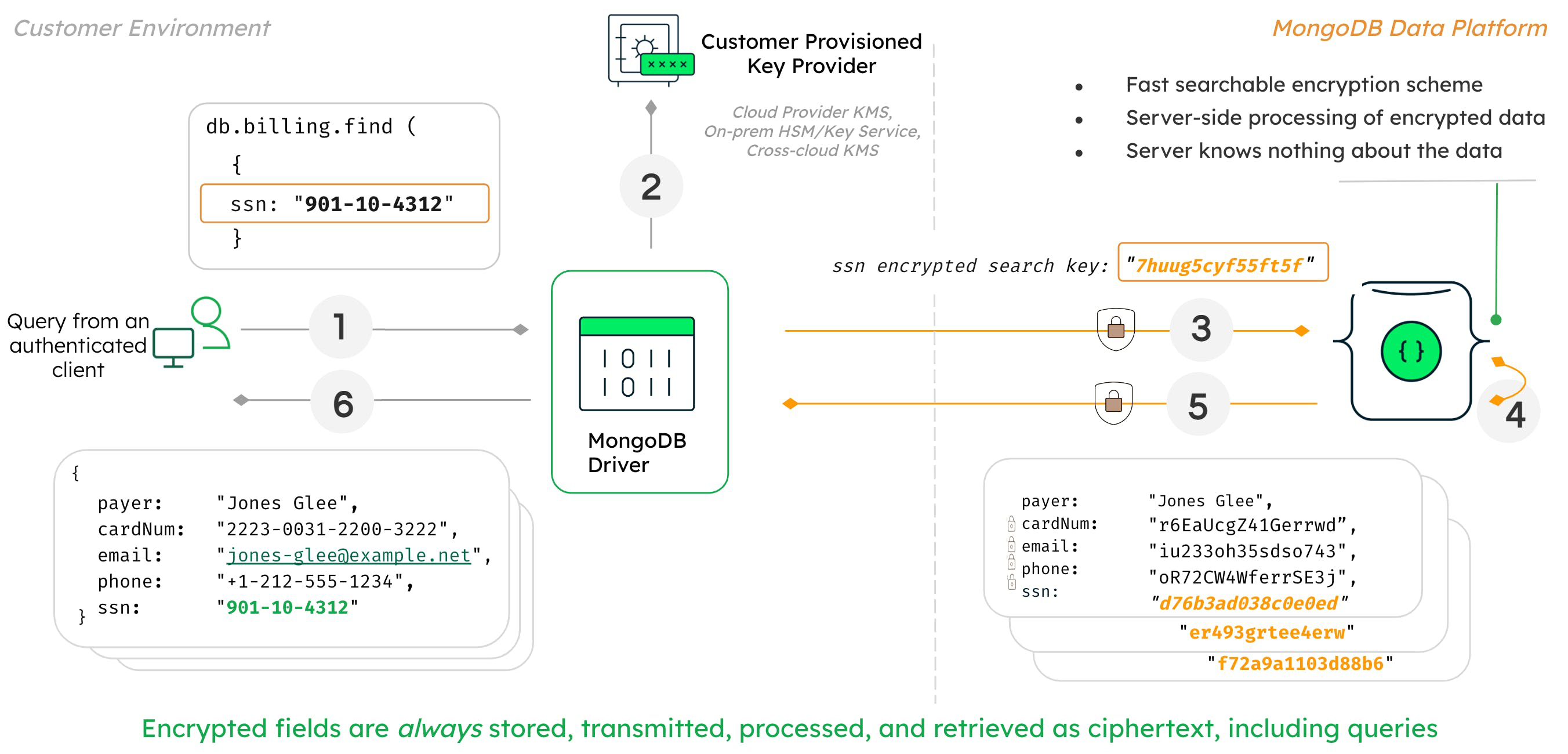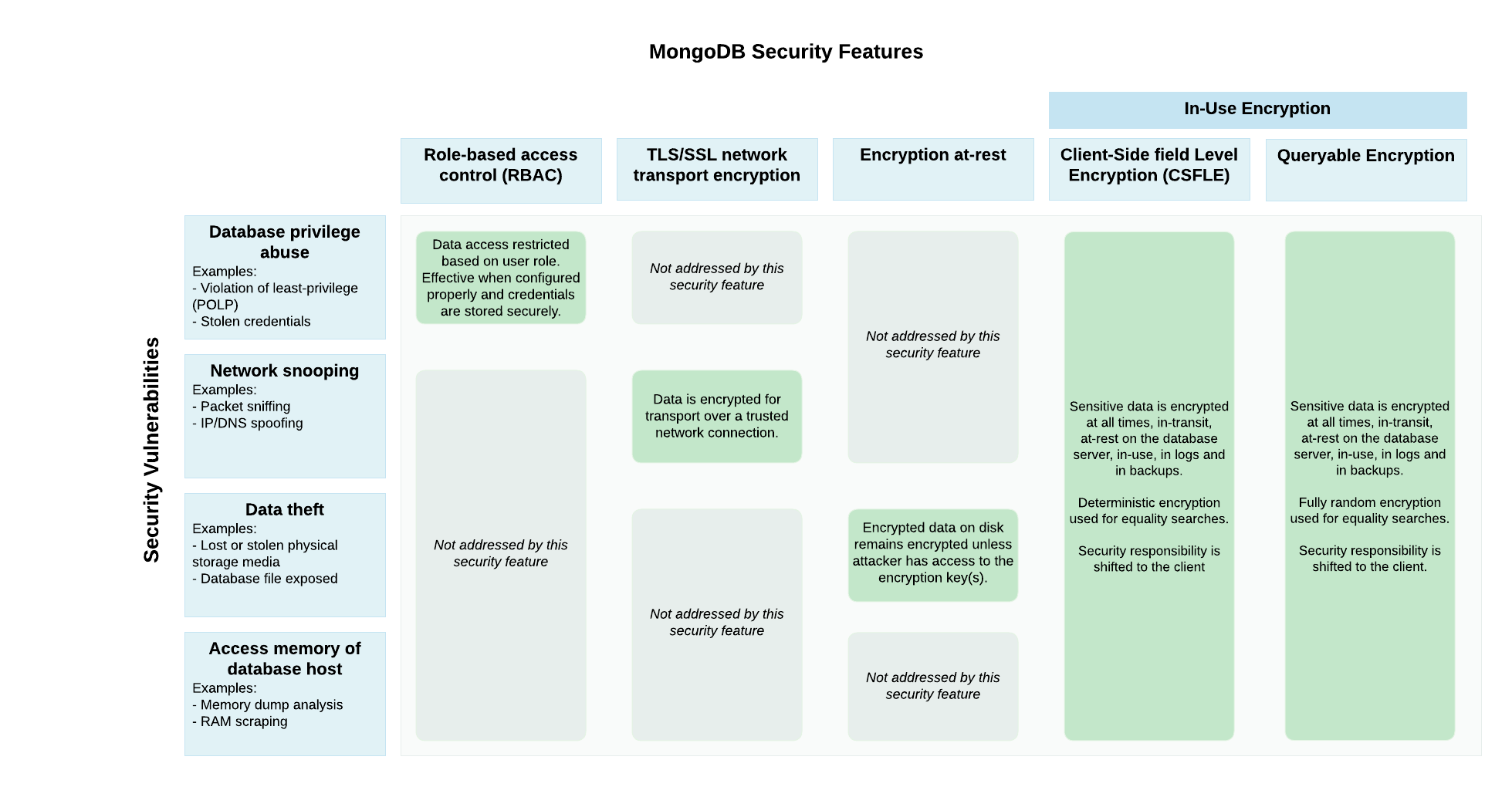- Security >
- Encryption >
- In-Use Encryption >
- Introduction >
- Features
Features¶
On this page
Overview¶
On this page, you can learn about the security benefits of , how works and compares to other security mechanisms supported by MongoDB. You can also view a fictional scenario that demonstrates the value of
in securing your data.
is a feature of MongoDB that enables a client application to
encrypt data before transporting it over the network using fully randomized encryption, while maintaining queryability. Sensitive data is transparently encrypted and decrypted by the client and only communicated to and from the server in encrypted form. The security guarantees for sensitive fields containing both low cardinality (low-frequency) data and high cardinality data are identical
Unlike Client-Side Field Level Encryption that can use Deterministic Encryption,
uses fast, searchable encryption schemes based on
Structured Encryption that always encrypts a given cleartext input value to a different encrypted output value.
How Works¶
The diagram below shows the process and architecture of how is used in a customer environment.

In this diagram, the user is able to query on fully randomly encrypted data such as SSN number.
- The process and mechanisms that makes this possible within the
- framework are as follows:
- When the application submits the query, MongoDB drivers first analyze the query.
- The driver recognizes the query is against an encrypted field and
requests the encryption keys from the customer-provisioned key
provider such as:
- AWS Key Management Service (AWS KMS)
- Google Cloud KMS
- Azure Key Vault
- Any KMIP-enabled provider
- The driver submits the query to the MongoDB server with the encrypted fields rendered as ciphertext.
- Queryable Encryption implements a fast, searchable scheme that allows the server to process queries on fully encrypted data, without knowing anything about the data. The data and the query itself remain encrypted at all times on the server.
- The MongoDB server returns the encrypted results of the query to the driver.
- The query results are decrypted with the keys held by the driver and returned to the client and shown as plaintext.
functions with the help of the following data structures. It is critical
that these are not modified or deleted, or query results will be incorrect.
- adds a
__safeContent__field to documents in any collection where there’s a
encrypted field.
- creates three metadata collections in the same database as the collection where there’s a encrypted field. These are named as follows:
enxcol_.<collectionName>.escenxcol_.<collectionName>.eccenxcol_.<collectionName>.ecoc
Warning
Do not modify these data structures or query results will be incorrect and security could be impacted.
keeps encrypted fields secure in the following scenarios:
- Direct access to encrypted fields by a database superuser
- Access to encrypted fields by reading the server’s memory
- Capture of encrypted fields over an insecure network
- Access to on-disk encrypted fields by reading database or backup files
- Frequency analysis attacks by identifying patterns in encrypted documents
While all clients have access to the non-sensitive data fields, only appropriately-configured clients are able to run read and write queries using the encrypted data fields.
Important
Remote
- When you use in production, you must use a remote
- (KMS) to store your encryption key.
To view a step-by-step guide demonstrating how to use a remote KMS with , see <qe-tutorial-automatic-encryption>.
To view a list of all supported KMS providers, see <qe-fundamentals-kms-providers>.
To learn more about why you should use a remote KMS, see Reasons to Use a Remote KMS.
Other Security Mechanisms¶
This section describes the following security mechanisms supported by MongoDB and explains their use cases and limitations:
- <qe-features-role-based-access-control>
- <qe-features-encryption-at-rest>
- <qe-features-transport-encryption>
Role-Based Access Control¶
Role-Based Access Control is a security mechanism that allows administrators to grant and restrict collection-level permissions for users. With the appropriate role definition and assignment, this solution prevents accidental disclosure of data and access.
Role-Based Access control cannot protect against the following scenarios:
- Capture of the data over an insecure network
- Access to on-disk data by reading database or backup files
- Access to data by reading the server’s memory
- Direct access to data by a database superuser
To learn more, see Role-Based Access Control.
Encryption at Rest¶
Encryption at Rest is a mechanism that encrypts database files on disk. This mechanism prevents a person who lacks database credentials, but has access to the computer hosting your database, from viewing your data.
This mechanism does not protect your data against the following scenarios:
- Capture of the data over an insecure network
- Access to data by reading the server’s memory
- Direct access to data by a database superuser
To learn more, see Encryption at Rest.
Transport Encryption (TLS/SSL)¶
Transport Encryption using TLS/SSL encrypts your data over the network. TLS/SSL protects your data as it travels over an insecure network, but cannot protect your data from a privileged user or as it sits on disk.
To learn more, see Transport Encryption using TLS/SSL
Important
Use the Mechanisms Together
To secure a production deployment, use all the security mechanisms discussed in this guide together. The mechanisms are not mutually exclusive.
Comparison of Features¶
The following diagram describes security features MongoDB supports and the potential security vulnerabilities that they address:

Important
Use the Mechanisms Together
To secure a production deployment, use all the security mechanisms discussed in this guide together. The mechanisms are not mutually exclusive.
Scenario¶
The following fictional scenario demonstrates the value of in securing your application’s data, and how
interacts with the other security mechanism discussed
in this guide.
In this scenario, we secure sensitive data on a medical care management system that stores patients’ personal information, billing information, and medical records for a fictional company, MedcoMD. None of the patient data is public, and specific data such as their social security number (SSN, a US government-issued id number), patient ID number, billing information, and medication information are particularly sensitive and subject to privacy compliance. It is important for the company and the patient that the data is kept private and secure.
MedcoMD needs this system to satisfy the following use cases:
- Doctors use the system to access patients’ medical records, billing information, and update medications.
- Receptionists use the system to verify patients’ identities using their contact information.
- Receptionists can view a patient’s billing information, but not their patient ID number.
- Receptionists cannot access a patient’s medical records.
MedcoMD is also concerned with the disclosure of sensitive data through any of the following methods:
- Accidental disclosure of data on a receptionist’s publicly-viewable screen.
- Direct access to the database by a superuser such as a database administrator.
- Capture of data over an insecure network.
- Access to data by reading the database server’s memory.
- Access to data by reading database or backup files.
What can MedcoMD do to balance the functionality and access restrictions of their medical care management system?
Solution¶
MedcoMD uses the following security mechanisms to satisfy their use cases and protect against the disclosure of sensitive medical data:
Transport Encryption (TLS/SSL) to secure data as it travels over the network.
Encryption at Rest to protect against disclosure of data by reading database or backup files.
Role-Based Access Control to limit the access of database users to the collections necessary for them to perform their tasks.
Encrypting sensitive fields with to satisfy the following use cases and constraints:
- Prevent reading data from server memory as the
encrypted data is never on the database server in
an unencrypted form.
Allow receptionists to verify patients’ identities and prevent accidental disclosure of sensitive data on a receptionist’s publicly viewable screen by providing receptionists with a client that is not enabled.
Allow doctors to view sensitive data privately in their offices by providing doctors with a enabled client.
Learn More¶
To view a list of security measures you should implement to protect your MongoDB deployment, see the Security Checklist.
To start using , see the <qe-quick-start>.